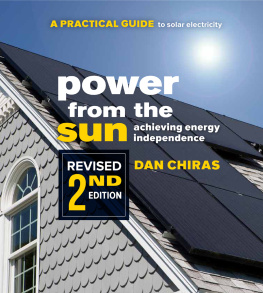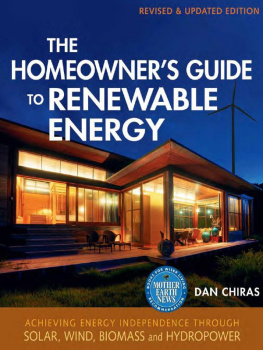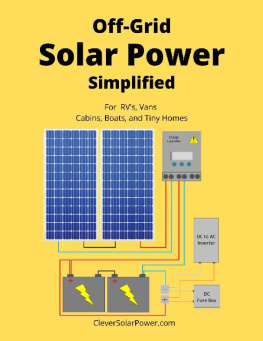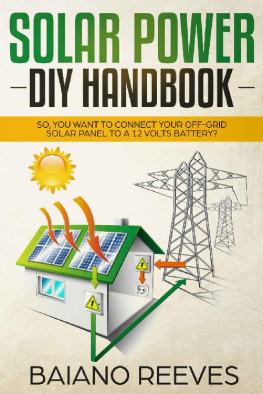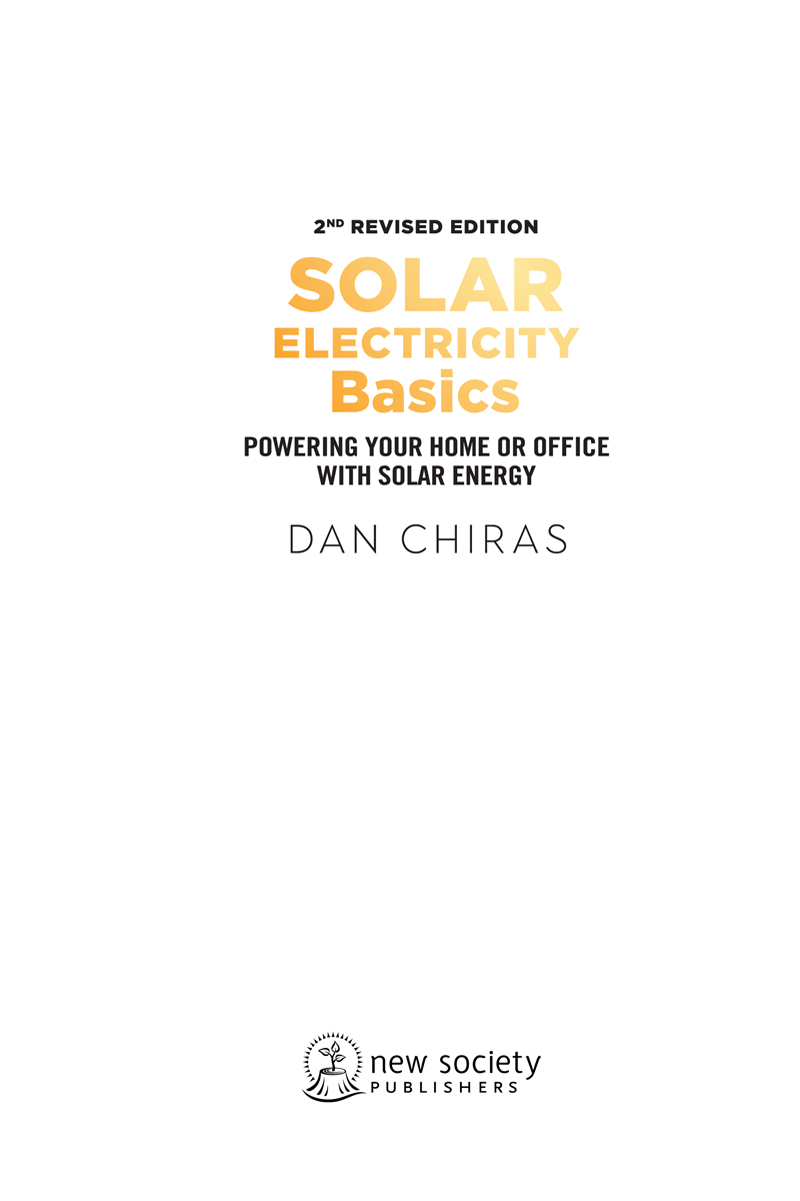Praise for
Solar Electricity Basics
Dan effectively takes the guess-work out of solar energy with simple explanations and instructions that anyone can follow. Just as importantly he presents all the options in a way that makes deciding which installation might best suit your needs. This is a must-read for anyone looking to make steps towards a resilient energy future.
Oliver M. Goshey, founder and director, Abundant Edge
Lucky for you, Dan Chiras strikes again. With his usual plain-spoken clarity, Dan makes a complex subject easy and accessible. The perfect guide for anyone to go solar!
Bruce King, author, The New Carbon Architecture
Thinking of going solar? Even if you intend to hire experts to install your system, it helps enormously to know a little about the technology, and how to assess your sites solar resource. Dan Chiras is the perfect guide; hes enthusiastic, knowledgeable, and makes it all easy to understand.
Richard Heinberg, Senior Fellow, Post Carbon Institute, and author, The End of Growth
Dan Chiras is the man who launched a thousand rooftop solar arrays. Dont even think about dabbling in photovoltaics without Dans guidance. Solar Electricity Basics, Second Edition is the essential go-to manual for getting a grip on the ins and outs of photovoltaic systems. Read it, use it, and harness the power of the sun on your home, farm, or homestead.
John D. Ivanko and Lisa Kivirist, co-authors, ECOpreneuring
Copyright 2020 by Daniel Chiras.
All rights reserved.
Cover design by Diane McIntosh.
Cover Images iStock.
Printed in Canada. First printing November, 2019.
This book is intended to be educational and informative. It is not intended to serve as a guide. The author and publisher disclaim all responsibility for any liability, loss or risk that may be associated with the application of any of the contents of this book.
Inquiries regarding requests to reprint all or part of Solar Electricity Basics, Revised & Updated 2nd Edition should be addressed to New Society Publishers at the address below. To order directly from the publishers, please call toll-free (North America) 1-800-567-6772, or order online at www.newsociety.com
Any other inquiries can be directed by mail to:
New Society Publishers
P.O. Box 189, Gabriola Island, BC V0R 1X0, Canada
(250) 247-9737
LIBRARY AND ARCHIVES CANADA CATALOGUING IN PUBLICATION
Title: Solar electricity basics : powering your home or office with solar energy / Dan Chiras.
Names: Chiras, Daniel D., author.
Description: 2nd revised edition. | Includes index.
Identifiers: Canadiana (print) 20190145528 | Canadiana (ebook) 20190145536 | ISBN 9780865719255
(softcover) | ISBN 9781550927184 (PDF) | ISBN 9781771423144 (EPUB)
Subjects: LCSH: Photovoltaic power generationHandbooks, manuals, etc. | LCSH: Solar energy
Handbooks , manuals, etc. | LCGFT: Handbooks and manuals.
Classification: LCC TK10857 .C56 2019 | DDC 621.31/244dc23

New Society Publishers mission is to publish books that contribute in fundamental ways to building an ecologically sustainable and just society, and to do so with the least possible impact on the environment, in a manner that models this vision.

Contents
Chapter 2: Understanding the Sun and Solar Energy
Things You Need to Know to Size and Mount a Solar Array
Chapter 3: Understanding Solar Electricity
Types of Modules, How They Are Rated, and Advances in Solar Technology
Chapter 4: Does Solar Electricity Make Sense?
Sizing a System and Evaluating Its Cost and Economic Benefits

CHAPTER 1
An Introduction to Solar Electricity
T he world is in the midst of a global renewable energy revolution. With installations of new solar and wind energy systems climbing rapidly, nearly 50 countries have pledged to be 100% dependent on renewable energy by 2050. Thats no pipe dream. Its highly doable. In fact, researchers at Stanford University project that the world could be 100% reliant on renewables in 20 to 40 years. The technologies and know-how are here, and in many parts of the world, so is the commitment.
Although the United States and Canada are not leading the race to a renewable energy future, significant progress is being made in both countries. In the US, for instance, solar, wind, biomass, hydroelectricity, and geothermal now produce about 17% of the nations electricityup from 7 to 8 percent at the beginning of the millennium.
One reason why renewable energy production has increased in recent years in the US is declining cost. Because of this, solar electric systems now consistently generate electricity at or below the cost of power from conventional sources like nuclear power and coal. With federal tax credits that have been in place for over a decade, solar electric systems on homes and businesses consistently produce electricity much cheaper than utilities. Declining costs and rising popularity have led many utilities to install solar and wind farms.
In this book, we will explore solar electric systems, technically known as photovoltaic systems or PV systems, for short. I will primarily present information on residential-scale PV systemssystems suitable for homes and small businesses. These systems generally fall in the range of 1,000 watts for very small, energy-efficient cabins or cottages to 5,000 to 15,000 watts for typical suburban homes. All-electric homes could require even larger systems (on the order of 25,000 watts). Small businesses typically require much larger systems. Before we move on, though, what does it mean when I (or a solar installer) refer to a 10,000-watt system?
Sizing Solar Systems: Understanding Rated Power
Solar electric systems are sized by their wattage. As just noted, a home might require a 10,000-watt system. The wattage rating is known as the rated power of a system. Rated power is also known as rated capacity.
The rated power of a system is the rated power of the modules (frequently, but improperly, referred to as panels) multiplied by the number of modules in the system. If your system contains ten 300-watt solar modules, its rated power, or capacity, is 3,000 watts. A system with twenty 300-watt modules is rated at 6,000 watts. To simplify matters, installers and other professionals convert watts to kilowatts. So, a 10,000-watt system is a 10-kilowatt (or kW) system. Thats a shorthand measure based on the fact that kilo in scientific jargon means 1,000.
But what does it mean when I say a modules rated power is 300 watts?
The rated power of a solar module is the instantaneous output of the module measured in watts under an industry-established set of conditions known as
Next page







